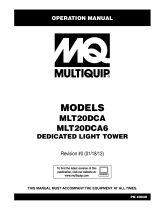
Safe Operating Procedure
PPE Required Traffic Lights
•Complete pre-start checklist
•Read Manufacturers Operation Manual (www.flexihire.com.au)
•Report any faults or damage to Flexihire 1300FLEXIHIRE
•Do not wear loose clothing or jewellery
•Do not operate equipment near pedestrians or people
•Do not operate without the appropriate PPE as detailed
•Do not operate equipment under the influence of drugs or alcohol •Assess the immediate work area for any hazards
•Control or eliminate all the risks associated with the hazards
•Hazards to check for that may require risk control-
❑Sloping ground ❑Pedestrian awareness
❑Traffic infringement ❑Falling objects
❑Any stored energy ❑Trip hazards
Risk Assessment
General Safety Instructions
Always operate vehicles in accordance to local road rules and regulations JOINING & SEPARATING TRAILERS
Ensure your vehicle is capable of towing the weight of the traffic lights, the
vehicle must be heavier than the load weight of the mobile cold room
Stabiliser legs MUST be lowered before separating trailers.
Ensure the tow hitch is secure on the vehicle Joining and separating tailers is to be done on level ground.
Do not attempt to lift the traffic lights, use the jockey wheel and drive the
vehicle to the correct position
Ensure drawbar pins are fitted into the joiner bar before connecting the two
trailers
Drive the vehicle to the traffic lights and use the jockey wheel to lower and
raise the hitch
Ensure wheel locking chains are engaged when the two trailers are joined.
Raise the locking mechanism on the tow ball hitch before lowering onto the
ball and ensure the locking mechanism has locked into the ball
Connect the tail light leads and test tail light operation
Place a safety pin on the latch so it cannot come loose If fitted, engage the hand brake before releasing the slave trailer from the
towing vehicle
Attach the safety chain or chains and cross chains if there are two ON SITE SET-UP & PACK UP
Ensure locking hitch is connected before driving Ensure when setting up that the traffic lights are not too close to traffic.
Ensure the electrical lights plug is secure Ensure that traffic lights are not in position to hinder or endanger pedestrian
traffic
Ensure the brake mechanism is turned off before towing Ensure traffic light position is suitable for solar panels to receive direct sun
light
Do not exceed the speed limit of the trailer. Recommended towing speed limit
is 80km/h
When raising mast into position it must be fully raised and locking pin
engaged
TRAFFIC RISK ASSESSMENT Do not stand under objects that could hit you e.g. raising mast
Traffic risk assessment should always be performed prior to set-up. When packing up, the slave unit (rear traffic unit) is to be positioned first.
Ensure the handbrake is engaged (if fitted) and wheel locks are removed and
stowed
Consider location of lights, vehicle traffic quantity and speed and direction of
pedestrians before setting up.
Raise stabiliser legs and swivel into transport position.
Lower the trailer to the towing vehicle using the jockey wheel
Connect safety chains and tail light connector.
Operating Safety Instructions
FMS10-5.1.3.9.22 SOP Traffic Lights
Version #: FLX 3.1
Issue: October 2021
Review: October 2026








